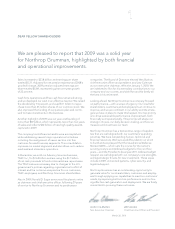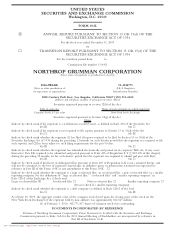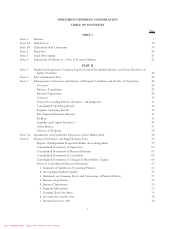Northrop Grumman 2009 Annual Report Download - page 13
Download and view the complete annual report
Please find page 13 of the 2009 Northrop Grumman annual report below. You can navigate through the pages in the report by either clicking on the pages listed below, or by using the keyword search tool below to find specific information within the annual report.Satellite System (NPOESS), the James Webb Space Telescope (JWST), Advanced Extremely High Frequency
(AEHF) payload, Space Tracking and Surveillance System (STSS) and many restricted programs.
Battle Management & Engagement Systems – designs, develops, manufactures, and integrates airborne early warning,
surveillance, battlefield management, and electronic warfare systems. Key programs include the E-2 Hawkeye,
Joint Surveillance Target Attack Radar System (Joint STARS), Broad Area Maritime Surveillance (BAMS)
unmanned aircraft system, the EA-6B Prowler, and its next generation platform, the EA-18G Growler.
Advanced Programs & Technology – creates advanced technologies and concepts to satisfy existing and emerging
customer needs. It matures these technologies and concepts to create and capture new programs that other
Aerospace Systems business areas can execute. Existing programs include the Navy Unmanned Combat Air
System (N-UCAS), the Airborne Laser (ABL), and other directed energy and advanced concepts programs.
ELECTRONIC SYSTEMS
Electronic Systems, headquartered in Linthicum, Maryland, is a leading designer, developer, manufacturer and
integrator of a variety of advanced electronic and maritime systems for national security and select non-defense
applications. Electronic Systems provides systems to U.S. and international customers for such applications as
airborne surveillance, aircraft fire control, precision targeting, electronic warfare, automatic test equipment,
inertial navigation, integrated avionics, space sensing, intelligence processing, air and missile defense,
communications, mail processing, biochemical detection, ship bridge control and radar, ship machinery controls,
and shipboard components. The segment is composed of seven business areas: Aerospace Systems; Defensive
Systems; Government Systems; Land Forces; Naval & Marine Systems; Navigation Systems; and Space &
Intelligence, Surveillance & Reconnaissance (ISR) Systems.
Aerospace Systems – provides sensors, sensor processing, integrated sensor suites, and radar countermeasure systems
for military surveillance and precision-strike; missile tracking and warning; and radio frequency electronic
warfare. Fire control radars include systems for the F-16, F-22A, F-35, and B-1B. Navigation radars include
commercial and military systems for transport and cargo aircraft. Surveillance products include the Airborne
Warning and Control System radar, the Multi-role Electronically Scanned Array (MESA) radar, the MP-RTIP,
the ship-board Cobra Judy Replacement radar, and multiple payloads on the P-8A. Radio frequency electronic
warfare products include radar warning receivers, self-protection jammers, and integrated electronic warfare
systems for aircraft such as the EA-6B, EA-18, F-16, and F-15.
Defensive Systems – provides systems that support combat aviation by protecting aircraft and helicopters from
attack, by providing capabilities for precise targeting and tactical surveillance, by improving mission availability
through automated test systems, and by improving mission skills through advanced simulation systems. A wide
variety of fixed wing and helicopter protection systems include threat detection and laser-based countermeasures
systems to defeat ground-launched infrared-guided missiles. Defensive Systems’ countermeasures systems are
currently installed on over 40 types of aircraft, many of which are conducting combat operations in Iraq and
Afghanistan. Targeting systems utilize lasers for target designation and precision weapon delivery, image
processing, and target acquisition, identification, and tracking. The LITENING targeting pod system is combat-
proven on the AV-8B, A-10A/C, B-52H, F-15E, F-16, and F/A-18A/C/D. Test systems include systems to test
electronic components of combat aircraft on the flight line and in repair facilities. Defensive Systems also
provides advanced simulators for use on test ranges and training facilities to emulate threats of potential
adversaries. Customers include the U.S. government and a wide variety of international allies.
Government Systems – provides products and services to meet the needs of governments for improvements in the
effectiveness of their civil and military infrastructure and of their combat and counter-terrorism operations. This
includes systems and system integration of products and services for postal automation, for the detection and alert
of chemical, biological, radiological, nuclear, and explosive material, and for homeland defense, communications,
and enterprise management. Key programs include: Flats Sequencing System; International Sorting Centers;
-3-
NORTHROP GRUMMAN CORPORATION
eBP - v54508-i003_a.pdf - Page 7 of 124 - March 11, 2010 - 20:02:39
























